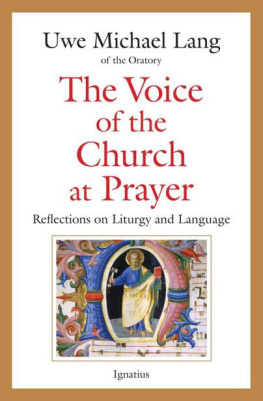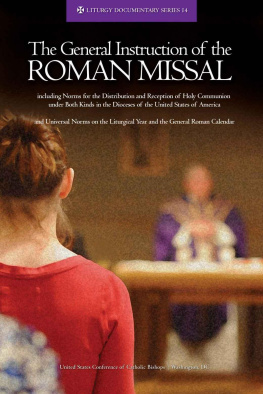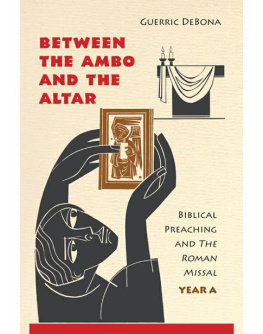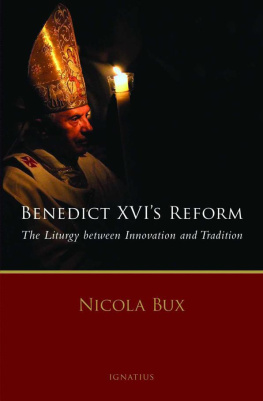Care for the Church and Its Liturgy
William H. Johnston
Care for the Church
and Its Liturgy
A Study of Summorum Pontificum
and the Extraordinary Form
of the Roman Rite
A PUEBLO BOOK
Liturgical Press Collegeville, Minnesota
www.litpress.org
A Pueblo Book published by Liturgical Press
Cover design by Jodi Hendrickson.
Excerpts from the English translation of Documents on the Liturgy, 19631979: Conciliar, Papal, and Curial Texts 1982, International Commission on English in the Liturgy Corporation (ICEL); excerpts from the English translation of The Roman Missal 2010, ICEL. All rights reserved.
Official texts of Benedict XVI, De usu extraordinario antiquae formae Ritus Romani ( Summorum Pontificum ); Epistula ad Episcopos Catholicae Ecclesiae Ritus Romani [Con Grande Fiducia] , as appear in Acta Apostolicae Sedis Vol. XCIX, N. 9 (2007): pages 77781 and 79599. Libreria Editrice Vaticana. Used by permission. English translations of these texts have been done by the author.
Excerpts from Sacramentum Caritatis: Sacrament of Charity; John Paul II, apostolic letter, Novo Millennio Ineunte (2001); and Pontifical Commission Ecclesia Dei, Universae Ecclesiae (2011). Libreria Editrice Vaticana. Used by permission.
Unless otherwise noted, all papal encyclicals and exhortations are from the Vaticans digital archives, accessible at http://www.vatican.va .
Unless otherwise noted, all citations of documents from the Second Vatican Council are taken from Vatican Council II: The Conciliar and Post Conciliar Documents , by Austin Flannery, OP, 1992 (Costello Publishing Company, Inc.). Used with permission.
Quotations from the liturgy constitution are taken from Constitution on the Sacred Liturgy: Second Vatican Council, December 4, 1963 (Collegeville, MN: Liturgical Press, 1963).
Unless otherwise noted, Scripture texts in this work are taken from the New Revised Standard Version Bible 1989, Division of Christian Education of the National Council of the Churches of Christ in the United States of America. Used by permission. All rights reserved.
2013 by Order of Saint Benedict, Collegeville, Minnesota. All rights reserved. No part of this book may be reproduced in any form, by print, microfilm, microfiche, mechanical recording, photocopying, translation, or by any other means, known or yet unknown, for any purpose except brief quotations in reviews, without the previous written permission of Liturgical Press, Saint Johns Abbey, PO Box 7500, Collegeville, Minnesota 563217500. Printed in the United States of America.
The Library of Congress has cataloged the printed edition as follows:
Library of Congress Cataloging-in-Publication Data
Johnston, William H., 1950
Care for the church and its liturgy : A Study of Summorum Pontificum and the Extraordinary Form of the Roman Rite / William H. Johnston. pages cm A Pueblo Book. Includes bibliographical references. ISBN 978-0-8146-6269-4 ISBN 978-0-8146-6294-6 (ebook) 1. Catholic Church. Pope (2005-2013 : Benedict XVI). Summorum Pontificum. 2. Catholic ChurchLiturgyHistory. I. Title.
| BX1975.J64 2013 |
| 264.02036dc23 | 2013031523 |
MAGISTRO PRAECIPUO
WILLIAM G. STOREY, D.M.S.,
QUI ABHINC ANNOS
ERUDITIONE ATQUE EXEMPLO SUO
ME PARTICIPANDO ET INQUIRENDO
STUDIUM LITURGIAE INGENIUMQUE DOCUIT
Contents
Preface and Acknowledgments
My first impression on reading Pope Benedict XVIs Summorum Pontificum and Con Grande Fiducia in July 2007whether on July 7 or a few days after I no longer rememberwas amazement at how many different things this one liturgical-legislative initiative, expressed in these two documents, was doing all at once. I thought those many things both interesting and important and during that summer drafted an initial reflection on the documents. Apart from several more focused and short-term projects along the way, this book has been my main research preoccupation during the past six years, and it incorporates much of the results of that research.
Such a study remains relevant even after Pope Benedicts papacy, for Summorum Pontificum is still in force. In his 2013 interview with Antonio Spadaro, SJ, Pope Francis referred to his predecessors action in allowing greater access to the traditional liturgy as prudent and motivated by the desire to help people who have this sensitivity, that is, an appreciation and longing for the prior liturgical forms. This might indicate, for example, those who would intend and promote its use more as an act of church politics (e.g., to oppose Vatican II) than pastoral care, or, on the other hand, those who would misinterpret its genuinely pastoral implementation in solely political or ideological categories and resist it on those grounds. But the popes words express no fundamental opposition to Summorum Pontificum and indicate no intention to revoke its provisions.
The core of this book is found in part 2, where chapters 4 and 5 offer analysis and commentaryby turns historical, liturgical, pastoral, canonical, and speculativeon the two documents issued by Pope Benedict. Part 1 prepares the way, with chapter 1 explaining the informed, appreciative, critical, and constructive method of the study, chapter 2 addressing some objections that might hinder a fresh reading of part 2, and chapter 3 outlining the multiple purposes I think this liturgical initiative was meant and designed to serve. Part 3 selects for further exploration two features of the new situation created by these documents: in chapter 6, some pastoral implications and in chapter 7, the key process of mutual enrichment. A concluding chapter rounds out the study with a review of various potential beneficial effects that may follow from a predominantly appreciative reception and implementation of the new structure and dynamics of the Roman Rite as instantiated by Pope Benedict in Summorum Pontificum , along with an invitation to choose to adopt such an approach so as to give what positive potential may follow a chance to emerge.
The argument of the book can be found in the text proper. But that argument receives a more extended presentation and development in the footnotes, many of which serve to support, illustrate, explain, qualify, or draw out consequences of points made in the text. Reading the notes should make the meaning and force of what is said in the text clearer.
This book on the liturgy and the church is addressed to both academic and pastoral audiences and seeks to be relevant and helpful to both. It even hopes to bridge the divide and lessen the perception of separation between them, for each benefits when it listens to and takes into consideration the voice and perspective of the other, received and engaged as a legitimate and natural dialogue partner. I hope the book will be informative, illuminating, and helpful for all who have an interest in the Catholic Church, in particular its (Roman Rite) liturgy and the way that liturgy serves the worship of God and the holiness and building up of Gods people in communion and mission. In view of the turmoil that has marked the liturgical and ecclesial scene over the past half century, and convinced Pope Benedict has with these two documents not (as it might be construed) entered the lists of the liturgy wars on one side but rather done a new thing that creates new possibilities, I have sought throughout to write in as balanced, open-minded, constructive, and irenic a spirit as possible, mindful of the different perspectives of different readers. With respect, I invite readers to consider the plausibility of that conviction, and to read in that same spirit.
I owe sincere thanks to those who provided assistance as this work was in progress. My colleagues Sandra Yocum and Dennis Doyle read those initial reflections in 2007 and responded with helpful comments and critique, and Bill Portier later read several chapters in draft form and offered further encouragement. Fred Jenkins (Latin) and Art Mosher (German) along with Martha Williams (Spanish) most kindly provided consultation and assistance regarding the translation of selected passages. Melissa Berry gave much appreciated commentary from the perspective of a social psychologist; though it was for the most part on material other than that in this book, it was most helpful to my learning and use of the categories of social psychology. John Huels and Chad Glendinning replied to some canonical questions and speculations; Glendinning and Lynda Robitaille helpfully recommended additional sources to research. Karen Kane read several chapters and offered insightful and useful observations that informed my sense of how best to present some of the material, especially in part 1. Jeremy Helmes read many of the chapters, on short notice no less, and replied in a timely and balanced fashion with comments that helped me judge my bearings. I offer my sincere thanks to each of them for their generous assistanceadding also the customary and very appropriate proviso, that while their assistance has improved what follows, any errors or shortcomings in the book are entirely my own responsibility.
Next page


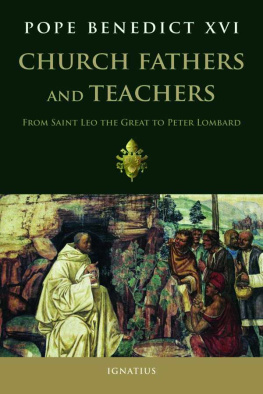

![Pope John XXIII - The Roman Missal [1962]](/uploads/posts/book/272720/thumbs/pope-john-xxiii-the-roman-missal-1962.jpg)
